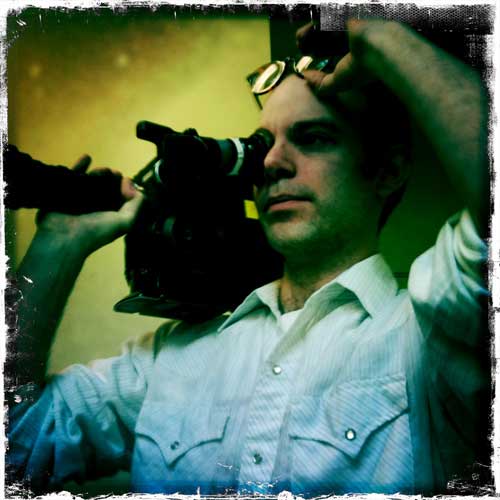I had the privilege of participating this afternoon in a cinéma vérité workshop taught by documentary filmmaker Zachary Levy. He’s in town for the Seattle screening of his first feature documentary, 3 years in the making, Strongman. It opened last night and deserves a much bigger audience than the handful of people who showed up to see it last night at Northwest Film Forum (I’ll be blogging a filmmaker review of the film soon).
As a cameraman on big shows like Oprah and 60 Minutes, Zach has a ton of experience in how NOT to make the kind of films he wants to make. Citing influences like Al and David Maysles, Zach pursues a simpler, “truthier” style in his own filmmaking known as cinéma vérité.
Eschewing even common cinematic accompaniments such as music (there is only one song in Strongman, and it accompanies the credit roll), Levy strips artifice to the bone, leaving his characters with nothing to be but themselves. To make this kind of film, Levy says, you want to find a subject who WANTS something – the stuff of classic character-driven plot. Then you start shooting, and trust that what happens will be interesting. Levy compared this approach to filmmaking with a jazz musician’s improvisational approach to music: the notes that are in front of you determine the ones you play next.
Here’s 12 things I learned from Levy today:
1. Hold the Shot. When you THINK the action is finished and you’ve got it, force yourself to count to 10. Something even more perfect just might happen, OR you might get something that will make your edit easier.
2. Wear long pants. Translation: be willing to use your body to get the shot. That means kneeling, standing for long periods of time, stretching beforehand, getting physical with it.
3. Keep your camera close. Simple body mechanics, but something I’ve overlooked: when you hold the camera in your hands actually touching your stomach or chest, it’s not only braced and more stable, but it’s better supported, so you can shoot much longer without getting tired.
4. Always shoot SHOTS. That is, think like a still photographer and frame things so they look good. That doesn’t mean going all “Living in Oblivion” style. But do shoot pretty rather than just shoot.
5. Look for the conflict. Stories that make for good verite involve conflict of some kind. In the case of Strongman, the conflict was mostly internal.
6. Shoot first, get releases later – if at all. Learning this one fact was worth twice the price of the workshop. As a former photojournalist, I have a solid working knowledge of “fair use” doctrine. But I’d been led to believe by other filmmakers that since films were commercial in nature, different rules applied. That turns out not to be the case with documentaries. Get releases when you can, he said, but don’t let NOT having them stop you from making your film. Got it.
7. Use signs as a form of narration. Levy included a brief “welcome to Orlando” sign in one scene as a way of revealing to audience where the action was happening, since the film has no narration.
8. Use visual metaphors. In one scene, Levy consciously includes a clock in the background to emphasize the fact that time was passing as one of the characters celebrates her birthday.
9. Watch the line. It’s an established filmmaking convention to keep characters on the same side of the frame throughout a scene, to avoid confusion about who’s who. You can break this convention, but be aware of it, and do it consciously for a reason.
10. Watch for repeat behavior. People behave predictably – so observe that and use it to your advantage. Over the years of filming, he came to know exactly where Stan would sit, and was able to make subtle adjustments to the table beforehand so that light would fall just enough to light the scene without Levy having to intervene.
11. Keep lighting simple. Levy was able to get acceptable levels of light in most of the scenes in Strongman by simply replacing the standard 60-watt bulbs with 80- or 100-watt bulbs. Side benefit: the natural light of the place was preserved, and he didn’t have to do any additional work to light the sets. Drawback was he had to use a big shoulder-bourne camera that was capable of shooting in low light. (That is less true today with small cameras with fat sensors like the Canon 5d).
12. Sound guy should “fade away.” Levy’s crew consisted of just one person – a person to record sound. And he made clear to this person that he or she was not to make eye contact with the subjects, as much as possible, so that there wasn’t any relationship developing that would show up on camera and have to be edited out.
Levy’s teaching another workshop tomorrow from noon-3pm, which I’ll attend and blog. Meanwhile, if you’re interested in seeing what a Slamdance-winning cinema verite film looks like, don’t miss this chance to see Strongman – it’s showing at NW Film Forum through Jan. 14.

Pingback: Documentary Filmmaking dvd offers tips from the trenches | Dan McComb